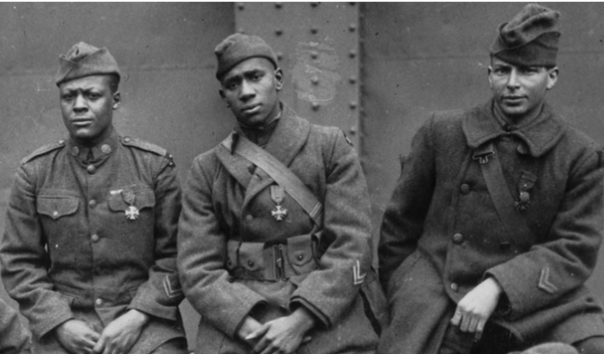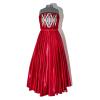As COVID-19 deaths spiked in 2020, Suzanne Firstenberg’s public art installation "In America: How could this happen…"
The Great War
Examine collections of the Museum's key resources on major themes in American history and social studies teaching. Additional resources can be found in the main search areas of the website.
Investigate the Great War using collections and teaching resources from the National Museum of American History. Check out additional collections objects and content at the museum's WWI hub.
Blog Post: WWI Women in Uniform
Resource Type(s): Reference Materials,
Date Posted: 7/13/2012
In this post, students will learn about the thousands of American women who volunteered in World War I through their uniforms. Most of the women's uniforms in the Museum's collections from WWI belong to civilian relief and welfare organizations, like the Salvation Army, not to the armed forces, and represent the participation of tens of thousands of American women in the Great War. This post, written by Bart Hacker, Senior Curator of Armed Forces History, is published on the Museum's "O Say Can You See?" blog.
Building Ships for Victory, 1917-1945
Resource Type(s): Reference Materials, Primary Sources,
Date Posted: 6/1/2009
Students will learn how the United States mass produced huge merchant fleets to support the soldiers fighting overseas in this section of On the Water: Stories from Maritime America, an online exhibition. Students will understand that merchant seamen and ships played a vital role in winning both world wars of the 20th century, and learn about the men and women who built the ships and risked their lives sailing them while playing a vital and unheralded role in the American war effort.
Cher Ami
Resource Type(s): Artifacts, Primary Sources,
Date Posted: 12/31/2010
Cher Ami was a registered Black Check cock carrier pigeon, one of 600 birds owned and flown by the U.S. Army Signal Corps in France during World War I. He delivered twelve important messages within the American sector at Verdun; on his last mission, October 4, 1918, he was shot through the breast and leg by enemy fire but still managed to return to his loft with a message capsule dangling from the wounded leg. The message Cher Ami carried was from Major Charles S. Whittlesey's "Lost Battalion" of the Seventy-seventy Infantry Division that had been isolated from other American forces. The message brought about the relief of the 194 battalion survivors, and they were safe behind American lines shortly after the message was received.
For his heroic service, Cher Ami was awarded the French Croix de Guerre with palm. He was returned to the United States and died at Fort Monmouth, N.J. on June 13, 1919, as a result of his wounds. Cher Ami was later inducted into the Racing Pigeon Hall of Fame in 1931, and received a gold medal from the Organized Bodies of American Pigeon Fanciers in recognition of his extraordinary service during World War I.
Distinguished Service Cross Medal
Resource Type(s): Artifacts, Primary Sources,
Date Posted: 1/20/2011
The Distinguished Service Cross, the DSC, is the second highest award for valor bestowed on a solider. President Woodrow Wilson established the award on January 2, 1918. The DSC is awarded to a person who, while serving in any capacity with the army, distinguished himself or herself by extraordinary heroism not justifying the award of a Medal of Honor: while engaged in an action against an enemy of the United States; while engaged in military operations involving conflict with an opposing or foreign force; or while serving with friendly foreign forces engaged in an armed conflict against an opposing armed force in which the United States is not a belligerent party. The act or acts of heroism must have been so notable and have involved risk of life so extraordinary as to set the individual apart from his or her comrades.
This Distinguished Service Cross was awarded to General John J. Pershing.
Doughboy Uniform
Resource Type(s): Artifacts, Primary Sources,
Date Posted: 1/24/2011
Enlisted soldier's uniform. The brown, doughy color of the uniform led to these soldiers being referred to as "doughboys," though the exact derivation of the nickname has been debated.
Use this Investigation Sheet to guide students through describing the object and analyzing its meaning.
Founding Fragments: World War I Women's Uniform
Resource Type(s): Reference Materials, Interactives & Media,
Date Posted: 5/23/2014
How did women serve in uniform during World War I? In this episode, host Tory Altman joins Curator Margaret Vining of the Museum's Division of Armed Forces History to talk about women's service in the conflict, and how their contributions helped the cause of the woman suffrage movement.
History Explorer Podcast: Women's Military History
Resource Type(s): Interactives & Media, Worksheets,
Duration: 14 Minutes
Date Posted: 3/28/2013
In this episode of History Explorer, curators Bart Hacker and Margaret Vining discuss the roles that women have played in the military throughout history, their research, and the 2013 announcement of a policy to allow women in combat. The resource set includes a teacher guide, student worksheet, and related images.
Man-in-Service Flag
Resource Type(s): Artifacts, Primary Sources,
Date Posted: 1/24/2011
When displayed in a home, business, or church, the flag indicates that one member of the family or other group is actively serving in the armed forces. A blue star indicates a member currently serving, while a gold star indicates a member killed while serving.
Stubby
Resource Type(s): Artifacts, Primary Sources,
Date Posted: 6/19/2012
While training for combat on the fields of Yale University in 1917, Private J. Robert Conroy found a brindle puppy with a short tail. He named him Stubby, and soon the dog became the mascot of the 102nd Infantry, 26th Yankee Division. He learned the bugle calls, the drills, and even a modified dog salute as he put his right paw on his right eyebrow when a salute was executed by his fellow soldiers. Stubby had a positive effect on morale, and was allowed to remain in the camp, even though animals were forbidden.
When the division shipped out for France aboard the SS Minnesota, Private Conroy smuggled Stubby aboard. Hidden in the coal bin until the ship was far at sea, Stubby was brought out on deck where the sailors were soon won over by the canine soldier. Stubby was soon discovered by Private Conroy's commanding officer who allowed Stubby to remain after the dog gave him a salute.
When the Yankee Division headed for the front lines in France, Stubby was given special orders allowing him to accompany the men to the front lines as their official mascot. The 102nd Infantry reached the front lines on February 5, 1918. Stubby soon became accustomed to the loud rifles and heavy artillery fire. His first battle injury occurred from gas exposure; he was taken to a nearby field hospital and nursed back to health. The injury left him sensitive to the tiniest trace of gas. When the division was attacked in an early morning gas launch, most of the troops were asleep. Stubby recognized the gas and ran through the trench barking and biting at the soldiers, rousing them to sound the gas alarm, saving many from injury. Stubby also had a talent for locating wounded men between the trenches of the opposing armies; he would listen for the sound of English and then go to the location, barking until paramedics arrived or leading the lost soldiers back to the safety of the trenches. He even caught a German soldier mapping out the layout of the Allied trenches. The soldier called to Stubby, who put his ears back and began to bark. As the German ran, Stubby bit him on the legs, causing the soldier to trip and fall. He continued to attack the man until the U.S. soldiers arrived. For capturing an enemy spy, Stubby was put in for a promotion to the rank of sergeant by the commander of the 102nd Infantry. He became the first dog to be given rank in the United States Armed Forces. Later, Stubby was injured during a grenade attack, receiving a large amount of shrapnel in his chest and leg. He was rushed to a field hospital and later transferred to a Red Cross recovery hospital for additional surgery. When Stubby became well enough to move around at the hospital, he visited wounded soldiers, boosting their morale.
By the end of the war, Stubby had served in seventeen battles. He led the American troops in a pass-and-review parade and later visited with President Woodrow Wilson. He visited the White House twice and met Presidents Harding and Coolidge. Stubby was awarded many medals for his heroism, including a medal from the Humane Society. It was presented by General John Pershing, the commanding general of the United States Armies. He was awarded a membership in the American Legion and the YMCA. When his master, J. Robert Conroy, began studying law at Georgetown University, Stubby became the mascot of the Georgetown Hoyas. He died in 1926.
The Soldier’s Experience: Vietnam versus World War I
Resource Type(s): Primary Sources, Lessons & Activities,
Duration: 90 Minutes
Date Posted: 5/6/2010
Analyze museum artifacts and first-person accounts of World War I and the Vietnam War, then take on the role of soldiers and a news team to present a newscast about the experience of fighting in these two wars. This lesson plan (which includes background information and full-color primary sources) was produced to accompany the exhibition The Price of Freedom: Americans at War, by the Smithsonian's National Museum of American History.
Treaty of Versailles
Resource Type(s): Reviewed Websites, Primary Sources, Lessons & Activities,
Duration: 90 Minutes
Date Posted: 10/13/2016
This historical investigation is aligned with the C3 Framework and from C3teachers.org.
The compelling question “Can peace lead to war?” offers students an opportunity to explore the historic controversy surrounding the extent to which the Treaty of Versailles caused World War II. Students consider not only the stipulations of the peace treaty but also the nature of historical interpretation by following the voices of historians throughout the inquiry. While progressing through the inquiry, students consider the original vision of the Treaty of Versailles, the conditions of the treaty itself, and the reactions to the treaty both at the time and by modern-day historians.
World War I
Resource Type(s): Reference Materials,
Date Posted: 10/14/2008
Americans reluctantly entered Europe's "Great War" and tipped the balance to Allied victory. The United States emerged from the war a significant, but reluctant, world power. Students will learn about American involvement in World War I and how American industrial and military might broke the stalemate that had existed for three bloody years on Europe's Western Front in this section of the online exhibition, The Price of Freedom: Americans at War. A non-flash version of this site is available: World War I.
World War I: Lessons and Legacies
Resource Type(s): Primary Sources, Lessons & Activities,
Date Posted: 11/15/2017
In honor of America's entry into "The War to End All Wars" in 1917, World War I: Lessons and Legacies explores the war and its lasting impact and far-reaching influence on American life. From the Great Migration to the 1918 flu pandemic and from the unionization movement to women's suffrage, World War I led to pivotal changes in America's culture, technology, economy, and role in the world. It redefined how we saw ourselves as Americans and its legacy continues today.
This free resource includes eight posters and an educators' guide, that can be used to spark an inquiry-based activity in your classroom. To receive the posters, submit a request through the Smithsonian Institution's Traveling Exhibition Service. The educators' guide can be downloaded here.

























